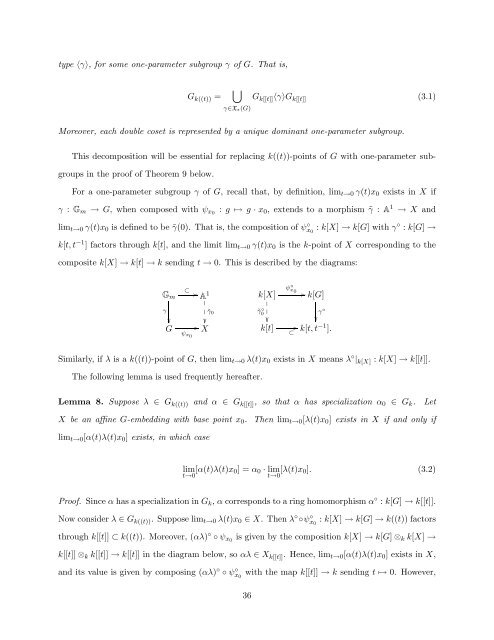Equivariant Embeddings of Algebraic Groups
Equivariant Embeddings of Algebraic Groups
Equivariant Embeddings of Algebraic Groups
You also want an ePaper? Increase the reach of your titles
YUMPU automatically turns print PDFs into web optimized ePapers that Google loves.
type 〈γ〉, for some one-parameter subgroup γ <strong>of</strong> G. That is,<br />
G k((t)) =<br />
⋃<br />
G k[[t]] 〈γ〉G k[[t]] (3.1)<br />
γ∈X ∗(G)<br />
Moreover, each double coset is represented by a unique dominant one-parameter subgroup.<br />
This decomposition will be essential for replacing k((t))-points <strong>of</strong> G with one-parameter subgroups<br />
in the pro<strong>of</strong> <strong>of</strong> Theorem 9 below.<br />
For a one-parameter subgroup γ <strong>of</strong> G, recall that, by definition, lim t→0 γ(t)x 0 exists in X if<br />
γ : G m → G, when composed with ψ x0<br />
: g ↦→ g · x 0 , extends to a morphism ˜γ : A 1 → X and<br />
lim t→0 γ(t)x 0 is defined to be ˜γ(0). That is, the composition <strong>of</strong> ψ ◦ x 0<br />
: k[X] → k[G] with γ ◦ : k[G] →<br />
k[t, t −1 ] factors through k[t], and the limit lim t→0 γ(t)x 0 is the k-point <strong>of</strong> X corresponding to the<br />
composite k[X] → k[t] → k sending t → 0. This is described by the diagrams:<br />
G m ⊂ <br />
γ<br />
A 1˜γ 0<br />
<br />
<br />
k[X]<br />
<br />
<br />
<br />
˜γ 0 ◦<br />
G<br />
ψx0<br />
X k[t]<br />
ψ ◦ x 0<br />
k[G]<br />
γ ◦<br />
⊂ k[t, t −1 ].<br />
Similarly, if λ is a k((t))-point <strong>of</strong> G, then lim t→0 λ(t)x 0 exists in X means λ ◦ | k[X] : k[X] → k[[t]].<br />
The following lemma is used frequently hereafter.<br />
Lemma 8. Suppose λ ∈ G k((t)) and α ∈ G k[[t]] , so that α has specialization α 0 ∈ G k . Let<br />
X be an affine G-embedding with base point x 0 . Then lim t→0 [λ(t)x 0 ] exists in X if and only if<br />
lim t→0 [α(t)λ(t)x 0 ] exists, in which case<br />
lim [α(t)λ(t)x 0] = α 0 · lim[λ(t)x 0 ]. (3.2)<br />
t→0 t→0<br />
Pro<strong>of</strong>. Since α has a specialization in G k , α corresponds to a ring homomorphism α ◦ : k[G] → k[[t]].<br />
Now consider λ ∈ G k((t)) . Suppose lim t→0 λ(t)x 0 ∈ X. Then λ ◦ ◦ψ ◦ x 0<br />
: k[X] → k[G] → k((t)) factors<br />
through k[[t]] ⊂ k((t)). Moreover, (αλ) ◦ ◦ ψ x0<br />
is given by the composition k[X] → k[G] ⊗ k k[X] →<br />
k[[t]] ⊗ k k[[t]] → k[[t]] in the diagram below, so αλ ∈ X k[[t]] . Hence, lim t→0 [α(t)λ(t)x 0 ] exists in X,<br />
and its value is given by composing (αλ) ◦ ◦ ψ ◦ x 0<br />
with the map k[[t]] → k sending t ↦→ 0. However,<br />
36
















